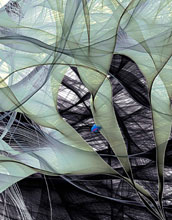Multimedia Gallery
Transport III
Transport III
"Transport III," from the Gallery of Eric J. Heller. Explanation of image, as taken from Heller Gallery: Transport III, another image in the Electron Flow Series, emphasizes the phenomenon of "caustics", or lines of accumulation where we look edge on. Loosely speaking, caustics are edges, lines along which one object or space ends and another begins. But edges are usually much more. In a drawing, caustics determine where a line should fall, and where it should begin and end. If the object being rendered is a smooth, three-dimensional form, light will usually collect or diminish rapidly at an edge, and detail will accumulate there. This is because the caustic of a curved surface is where we look tangent to (ex. along) the surface. If we imagine the surface as a thin shell of smoky plastic in front of a uniform gray sky, then the caustics will be very dark, because there light must pass through much more material to get through than at a typical place. Whether by training or by instinct, we associate a line in a simple drawing with a caustic in the real world. Even the cave painters 50,000 years ago knew these tricks and rendered some images of animals with subtle use of line to represent caustics.
But caustics are not always found at the obvious places. Caustics are found whenever there is "projection" to lower dimension. When we see something which is really three-dimensional, we automatically are projecting it onto the plane of our retina, using only two dimensions. Nowhere are caustics as beautiful as when looking through a thin folded translucent sheet, such as translucent kelp. One of the caustics we are bound to see is called a "cusp." It happens when a flat part of the kelp develops a fold as we follow up along a blade. At a definite point, we start to see two new edges or caustics arise where before there were none.
Heller's work was included in the exhibit "Approaching Chaos," shown at the National Science Foundation (NSF) headquarters in Arlington, Va., July thru October 2002, as part of "The Art of Science Project." The Art of Science Project was conceived and implemented by a cross-directorate committee of NSF staff. Its purpose is to bring to NSF, original works of art that visually explore the connections between artistic and scientific expression.
This image is copyright and was included in the NSF Multimedia Gallery with permission from the owner. See "Restrictions" below regarding use of this image. [Research supported by Harvard's NSEC (NSF) grant.] (Date of Image: 2001)
Credit: Eric J. Heller, Harvard University
Special Restrictions: Copyright 2001 Eric J. Heller; not for publication without permission of author. Contact at mailto:slheller@comcast.net.
Images and other media in the National Science Foundation Multimedia Gallery are available for use in print and electronic material by NSF employees, members of the media, university staff, teachers and the general public. All media in the gallery are intended for personal, educational and nonprofit/non-commercial use only.
Images credited to the National Science Foundation, a federal agency, are in the public domain. The images were created by employees of the United States Government as part of their official duties or prepared by contractors as "works for hire" for NSF. You may freely use NSF-credited images and, at your discretion, credit NSF with a "Courtesy: National Science Foundation" notation.
Additional information about general usage can be found in Conditions.
Also Available:
Download the high-resolution JPG version of the image. (1 MB)
Use your mouse to right-click (Mac users may need to Ctrl-click) the link above and choose the option that will save the file or target to your computer.



